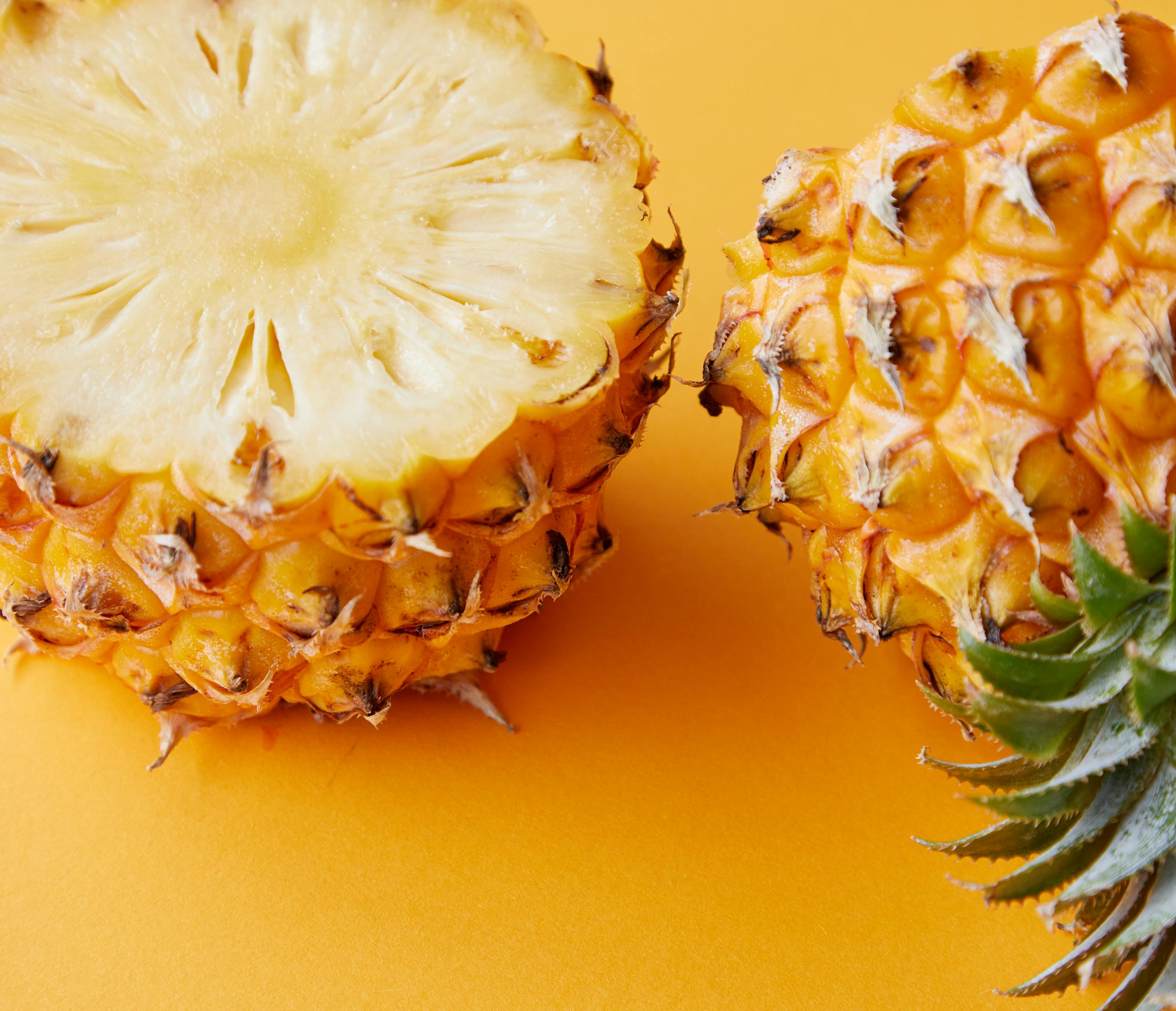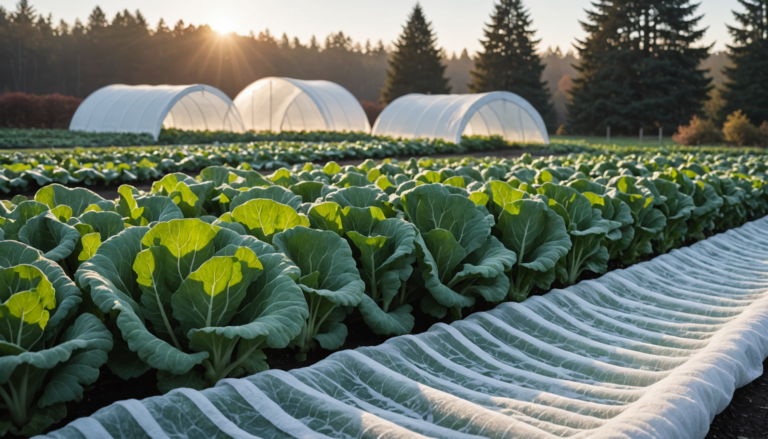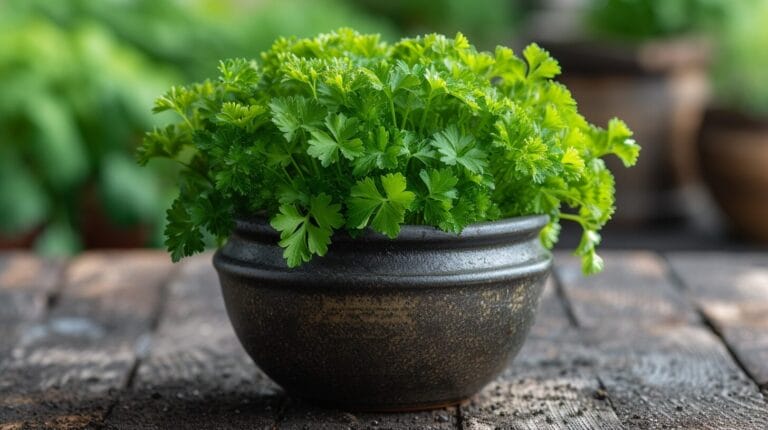When I first decided to grow a pineapple at home, I realized it’s not as complicated as it seems—but it does require some specific steps and care. From choosing the right crown to understanding soil and sunlight needs, there’s a method to help your plant thrive indoors. If you want to know how to avoid common mistakes and give your pineapple the best start, keep following along—I’ll share what I’ve learned through experience and research.
Understanding the Pineapple Plant: Basics to Grow a Pineapple Successful

What is a Pineapple Plant? Key Characteristics and Growth Habit
Although many people call it a pineapple tree, the pineapple plant is actually a tropical herbaceous perennial with a unique growth habit. Its rosette of long, spiky green leaves grows close to the ground, forming a sturdy base. When planting pineapple crown, it’s important to understand this growth habit to provide the right care. (Wikipedia, Britannica)
The plant doesn’t develop a woody trunk like a tree but produces a central stem that supports the fruit. To help your pineapple plant thrive, regular foliar spray with nutrient solutions can enhance leaf health and boost growth.
Choosing the Right Pineapple Crown for Planting
When you’re ready to plant your pineapple, selecting the right crown is crucial for a healthy start. I always choose a fresh, green pineapple crown free from bruises or dryness. Before you plant the pineapple crown, gently remove any leftover fruit flesh to prevent rot.
Let the crown dry for a few days until the soil is dry to the touch, reducing the risk of mold. When you place the crown into the soil, ensure it’s firm and upright, covering the base but not burying the leaves.
This careful selection and preparation will help your new pineapple plant establish strong roots and grow healthy. Serving others with homegrown fruit begins with this simple, thoughtful step.
References:
The Role of Root Development in Growing a Pineapple at Home
Since strong roots form the foundation of any healthy pineapple plant, understanding their development is key to growing pineapples successfully at home. When you first plant your pineapple crown, keeping the soil moist encourages root development, which helps the plant establish itself quickly.
The right planting techniques, like planting the crown just deep enough to cover the base, prevent rot and promote steady growth. Typically, the plant may start growing new shoots within a few weeks as roots take hold. Watching for this early sign shows your care is working.
How to Plant a Pineapple Tree: Step-by-Step Guide for Houseplant Enthusiasts
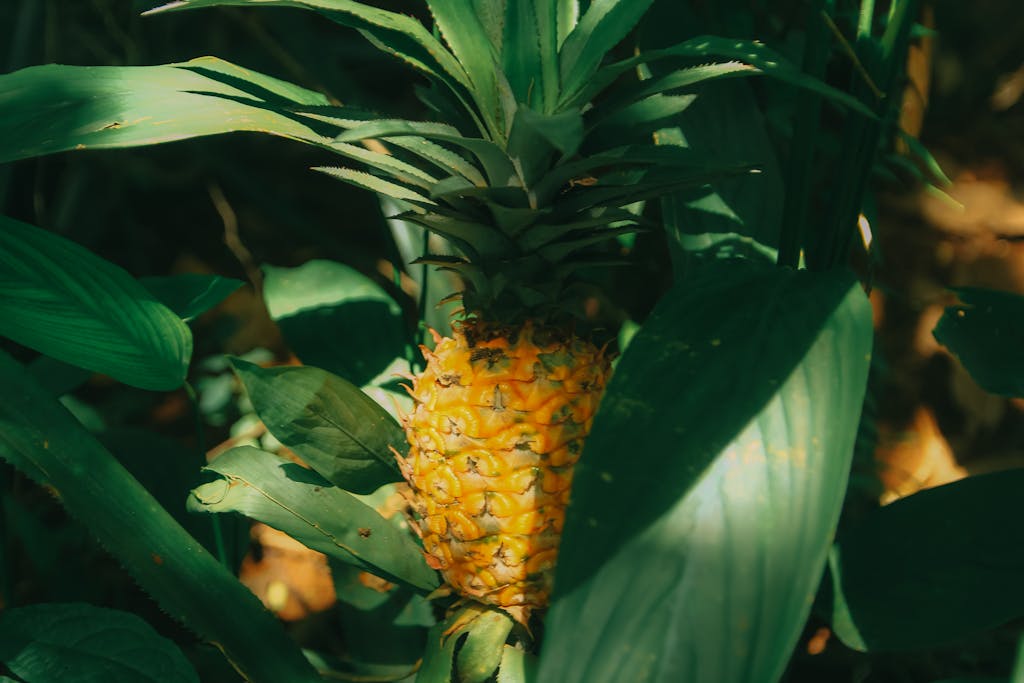
Preparing the Pineapple Crown for Planting
Before you plant your pineapple crown, you’ll want to prepare it properly to guarantee healthy growth. Start by gently twisting or cutting the crown off the fruit, then carefully remove any excess fruit flesh to prevent rot.
Next, strip away a few of the lower leaves to expose about an inch of the base where the root primordia—the tiny root buds—will develop. Let the crown dry for a day or two; this step helps prevent fungal infections during the planting process.
When you’re ready, make sure the soil around the crown is loosened and ready to support root growth. Taking these simple steps to prepare your pineapple crown for planting sets the stage for a thriving plant that you can share with others.
Soil and Container Recommendations for Pineapple Plants
When choosing soil and containers for your pineapple plant, I recommend selecting a well-draining, sandy loam mix to prevent waterlogging and root rot. Pineapples thrive best in a potting mix that combines clay or sandy soil with ample organic matter, ensuring nutrients flow freely while maintaining moisture balance.
Using a container with drainage holes is essential to avoid standing water, which can harm roots. I find that adding compost or aged manure enriches the soil naturally, supporting healthy growth and sustainability.
This approach not only nurtures your pineapple but also aligns with eco-friendly practices that benefit the environment. By carefully selecting the right soil and container, you’re setting a strong foundation to serve both the plant and those who’ll enjoy its fruit.
Watering and Light Requirements to Help Pineapple Plants Thrive
Although pineapple plants are fairly resilient, I’ve learned that consistent watering and proper light exposure are key to helping them thrive. For effective plant care, keep the soil moist but never soggy—overwatering can harm roots. I water my pineapple once the top inch of soil feels dry.
Pineapples prefer bright, indirect light; direct sunlight can scorch leaves, while too little light slows growth. Placing your plant near a south- or east-facing window provides the right balance.
Expert Recommendations and Personalized Advice to Grow a Pineapple Indoors
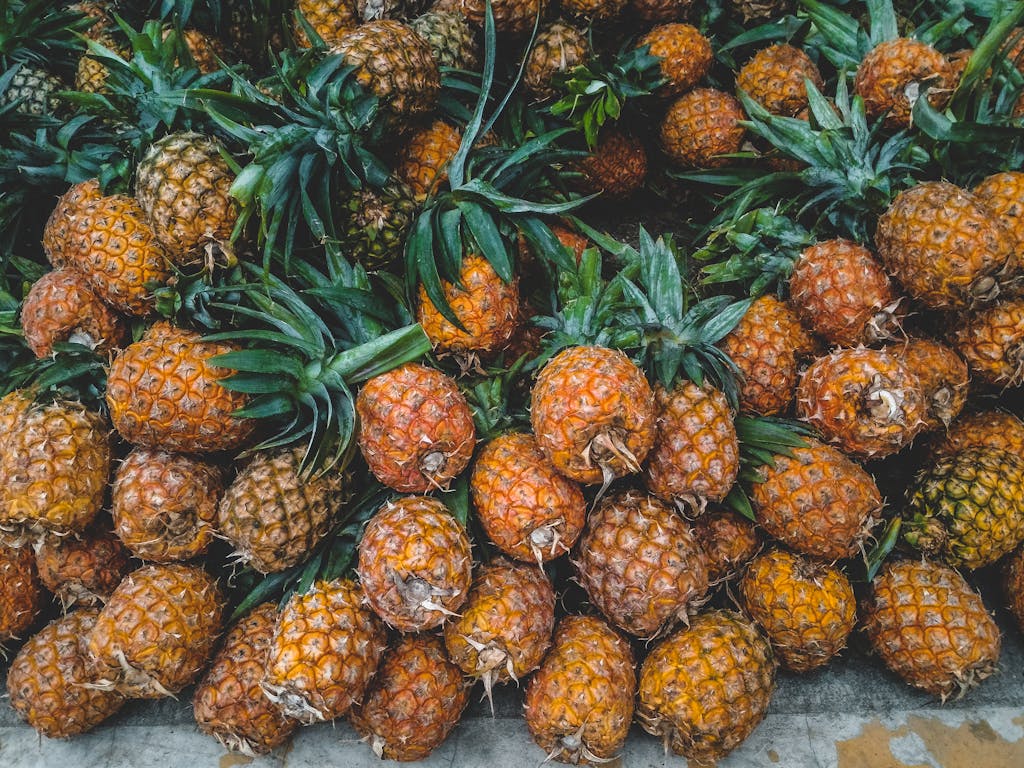
Common Challenges When Growing a Pineapple as a Houseplant
Even with the right care, you’ll face some unique challenges raising a pineapple plant indoors. One common issue is overwatering; pineapples need well-drained soil to prevent root rot. Maintaining proper humidity is essential, especially in drier climates where indoor air can be too dry for the plant to thrive. (Libguides)
Since pineapples prefer warm, tropical conditions, adjusting your home’s climate or placing the plant near a sunny window helps it grow strong. Waiting for the fruit to become ripe requires patience, but watching it develop is rewarding.
Pest control is another concern—mealybugs and scale insects can sneak in, so regularly inspecting your plant and using gentle, eco-friendly treatments keeps it healthy. Overcoming these challenges lets you serve others by sharing your thriving pineapple harvest.
Expert Tips for Ensuring Healthy Pineapple Root Growth
Since healthy roots are the foundation of a strong pineapple plant, I focus on creating the ideal environment right from the start. To encourage robust root growth, I select well-draining soil to prevent waterlogging, which can harm healthy roots.
I make sure to water my pineapple sparingly—just enough to keep the soil moist but never soggy. Overwatering is a common mistake that stunts root development.
I also apply a balanced, slow-release fertilizer every few months to provide essential nutrients that support root strength.
How to Promote Pineapple Fruit Development Indoors
While nurturing healthy roots lays the groundwork, encouraging fruit development indoors requires specific care and attention. To help your pineapple produce fruit, make sure to expose it to bright light daily. I place mine near a south-facing window where it receives full sun for at least six hours. This exposure mimics its natural environment and stimulates flowering, leading to a fresh pineapple.
Maintaining consistent warmth and humidity also supports development. I recommend feeding your plant with a balanced fertilizer every few weeks to supply essential nutrients. Remember, patience is key; pineapples take time to fruit indoors, but your dedication will reward others with sweet, homegrown pineapple.
Research and Studies on Pineapple Planting: Insights to Grow a Pineapple Better

Latest Findings on Pineapple Growth Cycles and Root Systems
Although pineapple plants have been cultivated for centuries, recent research sheds new light on their growth cycles and root development that can help you optimize your planting approach. Understanding pineapple growth cycles and root systems is key to successful pineapple planting and plant development.
Studies show that:
- Pineapple root systems remain shallow but spread wide, needing well-drained soil.
- Growth cycles have distinct phases: vegetative, flowering, and fruiting, each requiring specific care.
- Eco-friendly horticulture practices like mulching enhance root moisture and health.
- Timing planting to seasonal changes improves fruit yield and quality.
- Root pruning can stimulate stronger root growth and better nutrient uptake.
Understanding Pineapple Plant Nutrient Needs for Optimal Growth
Because pineapples have unique nutrient requirements, understanding these needs is essential to help your plants thrive. From my experience, a pineapple plant benefits most from balanced nutrients rich in nitrogen, phosphorus, and potassium. Using a fertilizer formulated specifically for pineapples guarantees they get what they need without overloading the soil.
Speaking of soil, maintaining a slightly acidic soil pH between 4.5 and 6.5 supports ideal nutrient uptake. I always recommend testing your soil before planting to adjust pH accordingly.
Embracing sustainable agriculture practices, like using organic fertilizers and minimizing chemical inputs, not only nourishes your pineapple plant but also protects the environment. When you care for your plants thoughtfully, you’re serving others by growing healthier fruit and promoting a greener world.
Addressing Misconceptions About Pineapple Plants as Houseplants
When you think of pineapple plants, you might picture them thriving only in tropical gardens, but many people mistakenly believe they can’t grow well indoors as houseplants. From my experience, with proper plant care and indoor gardening techniques, pineapple plants can flourish inside your home, contributing to sustainable agriculture on a small scale.
Research shows that misconceptions often arise from:
- Assuming pineapple plants need constant direct sunlight
- Believing they require outdoor soil conditions exclusively
- Overwatering due to misunderstanding their drought tolerance
- Thinking they grow too large for indoor spaces
- Underestimating the benefits of controlled indoor environments
Case Studies and Success Stories: Real Experiences Growing a Pineapple Tre

Long-term Care Considerations for Growing a Pineapple Plant at Home
Although growing a pineapple plant may seem straightforward at first, maintaining its health over time requires specific care routines that many beginners overlook. Long-term care is essential to serve your plant well and enjoy a fruitful harvest. Here’s what I’ve learned:
- Consistent watering without waterlogging keeps roots healthy.
- Applying balanced fertilizer every 6–8 weeks supports steady growth.
- Regularly removing dead leaves prevents disease and pests.
- Monitoring for pests ensures the plant remains strong.
- Timing the harvest carefully guarantees the sweetest pineapple.
Comparing Pineapple as a Houseplant Versus Outdoor Cultivation
Since pineapple plants adapt well to varied environments, I’ve found it insightful to compare growing them indoors as houseplants versus cultivating them outdoors.
As a houseplant, controlling temperature and watering is easier—you can provide consistent warmth and prevent overwatering by using well-draining soil. This setup suits those serving family or community by offering fresh fruit year-round inside.
Outdoor cultivation, however, benefits from natural sunlight and airflow, promoting robust growth if the local climate supports warm temperatures and moderate humidity. But it requires more attentive watering and soil management to avoid issues like root rot or pests.
Both methods have their merits, and real success stories show that tailoring care to your environment and purpose helps you serve others best by growing healthy, fruitful pineapple plants.
How Enthusiasts Learn to Successfully Grow a Pineapple Fruit Ind
Understanding the differences between growing pineapples indoors and outdoors sets a solid foundation, but real learning comes from hearing how enthusiasts manage to grow healthy pineapple fruits successfully. From my experience and shared stories, mastering planting techniques is key to nurturing a thriving pineapple plant that yields edible fruit.
For those serving others with fresh pineapple, these insights help:
- Select a bright, warm spot for growing pineapples.
- Water moderately, allowing soil to dry between sessions.
- Fertilize regularly, ideally about once a month.
- Use well-draining soil to prevent root rot.
- Be patient; pineapples take time but reward persistence.
Conclusion
Growing a pineapple at home is truly rewarding if you follow the right steps. By choosing a healthy crown, planting it carefully in well-draining soil, and giving it bright, indirect light and consistent moisture, you set yourself up for success. Remember to be patient and fertilize regularly. With a little care and attention, you’ll soon enjoy the satisfaction of watching your pineapple thrive—and maybe even taste your own homegrown fruit!
FAQs
1. What Are the Best Natural Fertilizers for Pineapple Plants?
I recommend using compost, well-rotted manure, and seaweed extract as natural fertilizers. They nourish pineapple plants gently, support soil health, and promote growth, helping you serve others by growing healthy, eco-friendly fruits at home.
2. Can Pineapples Be Grown Hydroponically at Home?
Yes, you can grow pineapples hydroponically at home! I’ve found it’s rewarding and eco-friendly, letting you nurture healthy plants without soil. It’s a wonderful way to serve others by sharing fresh, homegrown fruit.
3. How to Control Pests Naturally in Pineapple Cultivation?
I control pests naturally by introducing beneficial insects like ladybugs, using neem oil sprays, and encouraging companion plants that repel pests. These eco-friendly methods protect your pineapple crop while nurturing the environment we all cherish.
4. What Is the Ideal Soil Ph for Pineapple Growth?
I’ve found that pineapples thrive best in slightly acidic soil, with a pH around 4.5 to 6.5. Keeping this balance helps your plants grow strong and healthy, making your care truly rewarding.
5. Are There Any Companion Plants That Benefit Pineapples?
I’ve found that planting legumes like beans near pineapples helps enrich the soil with nitrogen. Companion herbs such as basil also deter pests, protecting pineapples naturally while creating a harmonious garden environment for all to enjoy.

